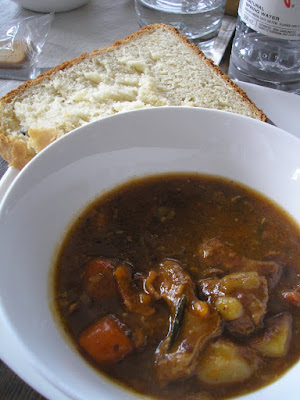Barry and I are currently running in a competition for Yoplait Yogurt. The rules are straight forward. Create one dish, either an app. or dessert which consists of 15% yoplait yogurt. Submit the recipe with photo. If they like what they see, a couple chef schools will recreate your dish. If they like what they taste, first prize is a thermomix. Second is an Ipad.
Stay tuned...

This is exciting because I produce a ton of pasta dishes in my domesticated Italiano household. Lo and behold, I do not always have time to braise lamb shanks for 14 hours to casually throw on a Gnocchi dish for two people. I do, however, have 1.5 hours. So this baby works great. Brown whatever, add appropriate vino, reduce au sec, add stock, sachet, cook for however long it takes to become love-me-tender, add mirepoix, cook accordingly, take credit for 14 hour braises. Bob's your uncle.

Straight from the pressure cooker; Beef Bourguignon, freshly made milk bread Take my word for it, this dish killed impressing people!*
*... my mom

Crisp Salmon Belly, Heirloom Beet Puree, Yogurt Basil Pistou, Watercress
To finish off, a F.O.H. buddy of mine left some pivotal notes about wine that I thought I would copy and paste here. So, enjoy.
Serving Wine with Food What, When and How to Serve Wine
Here are a few simple tips for serving wine and creating successful food and wine matching combinations:
Serving:
- Serve lighter wines before more full-bodied wines, younger wines before older wines, whites before reds and dry wines before sweet.
- Serve the wine at the appropriate temperature. Serve whites too cold and you will not smell or taste much. Serving reds too warm will make them taste flabby and alcoholic. Reds served too cold will taste overly tannic and acidic.
Ideal serving temperature guidelines:
Sparkling Wine 6-10 °C
Rosé Wine 9-12 °C
Lighter, unoaked Whites 8-10 °C
Fuller, oaked Whites 10-14 °C
Light Fruity Reds 14-16 °C
Medium, full Reds 16-18 °C
Late Harvest/Icewine 4-8 °C
- Decanting may be necessary for mature wines that throw a sediment- mature reds or port-styles -which can be bitter to the taste. It is normally not necessary to decant younger reds and whites.
- In terms of glassware, the simpler and plainer the glass the better. Glasses should be clear with a long stem. Tulip-shaped for whites, with a more rounded and larger bowl for reds. Sparkling wine is best served in tall and thin flutes, while Icewine can be served in white wine glasses.
- Clean glasses in very hot water, with no detergent coming into contact with the inside of the bowl. Air-dry or wipe with a clean linen cloth. Avoid storing glasses in cabinets or cardboard boxes which can leave an odour and affect the taste of the wine.
- Fill glasses no more than two-thirds full, so that the wine can breathe and be swirled around for full enjoyment of the bouquet and aromas.
Matching:
- Take the whole dish into account when matching. This includes the sauce and accompanying vegetables.
- You can also match the wine with the strongest flavour on the palate, eg. An apricot sauce accompanying a roast pork loin is more pronounced or flavourful than the roast itself and the wine should be chosen with that in mind.
- If you had to single out one attribute that makes wines easier to match with numerous food types and flavours, it is surely acidity. Without acidity, wine would taste sweet and flabby and make average-to-poor food companions.
- Wines with good acidity make an ideal foil for salty, smoky, oily or buttery foods, as the acidity cleanses and refreshes the palate.
- Wines with some residual sugar are good matches for spicy or hot dishes.
- Complementary and contrasting flavours can contribute to successful wine and food pairings. A complementary match is dessert with a sweet wine, where the sweetness provides the common bond. An example of contrasting flavours is a fish dish with a cream sauce paired with a high acid wine like Riesling or Sauvignon Blanc. The wine's acidity makes the sauce feel lighter and livelier and accentuates the flavour of the fish like a few drops of lemon would.
- Dessert wines should always be sweeter than the dessert.

No comments:
Post a Comment